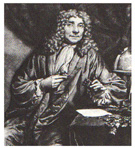
Anton van Leeuwenhoek holding a lens. Welcome Historical Museum.
|
|
|
|
|
|
|
|
|
|
Anton van Leeuwenhoek (1632 -1723)
 |
Anton van Leeuwenhoek holding a lens. Welcome Historical Museum. |
So, who was Anton van Leeuwenhoek?
Anton van Leeuwenhoek was born in Delft, Holland, on October 24th 1632. His father was a basket maker and his mother came from a family of brewers. His formal education appears to have lasted a short time, as he is listed as having only attended a school in Warmond. At the age of 16, Anton moved away from Delft to serve an apprenticeship as a linen draper. He came back to Delft in 1654 and established his own drapery business. As part of his work in this business, Leeuwenhoek used a lens to examine cloth for quality. This lens magnified things around three times. He also used the lens to look at objects in nature, such as insects and finger prints.
What else did Leeuwenhoek do?
Anton van Leeuwenhoek had a great interest in lenses and had learned to grind his own. He was not content with the magnification of only three times and set about making more powerful lenses. These lenses were actually very small, being about 3 mm in diameter, but were more powerful than those made by anyone else. They were single, double-convex lenses mounted between two brass sheets and were held close to the eye. These lenses were able to magnify up to about 300 times. When Leeuwenhoek wanted to examine anything, he mounted it on a pin placed behind the lens. He was able to bring it into focus by turning screws.
|
|
Facsimile of Anton van Leeuwenhoek's microscope. Welcome Historical Museum. |
Did he achieve anything else?
Leeuwenhoek examined lake water which in summer, became cloudy, whereas in winter it was clear. He noticed hundreds of tiny creatures swimming in a single drop through his microscope.
He made special microscopes so that he could observe the flow of blood in such things as rabbits' ears, bats' wings and tadpoles' tails.
He took samples of plaque from his own teeth and mixed them with water. When he looked at the mixture through his microscope he saw what he called "many very little living animalcules." These were some of the first recorded observations of what today we would call bacteria. Leeuwenhoek found that these were killed when he drank hot coffee.
What honours were awarded to him?
In 1680 Leeuwenhoek was elected a member of the Royal Society. He became famous all over Europe and in 1698, was asked to demonstrate circulation of the blood in an eel before Peter the Great of Russia. He was also visited by Queen Anne of England.
When did he die?
Anton van Leeuwenhoek died on 30th August, 1723, aged 91. No one had seen his finest microscopes and no one was able to make lenses as good as his, for at least another hundred years.